Zoom to Satins and False Satins
Marcy Petrini
April, 2021
When the pandemic lock-down took place, I was in the middle of teaching an in-person twill class at the Craft Center. At first, we were on hold, but as the pandemic continued, I was reminded of how much I missed teaching.
Enter zoom: I had read pros and cons of using it and how some things can only be taught in person. Maybe. We finished the twill class with successful projects and we embarked in a lacey weave class for the rest of 2020, again with successful projects. Using e-mails, phone calls and sending photos all helped. Well, we can’t touch the fiber or finished project, that’s true, but that’s also true for books, magazines, and the rest of the internet.
Talks, seminars, an interview, and now a study group on zoom all followed. In some ways it’s magical. I meet with people from all over the country; I have given seminars in the US as well to a wonderful guild in Canada; more seminars are scheduled – all from the comfort of my studio.
And even more important, my learning continues, not only from my own researching to teach and present, but also from students and participants. In the diverse group that comprises our study group, the breadth of knowledge is impressive.
For the study group month on satins and false satins I was reminded that sometimes I have forgotten to tell weavers that we cannot just duplicate the reverse of the tie-up to alternate the treadling between sateen (weft-dominant side) and satin (warp-dominant side). (See May and June 2017 blogs).
Let’s look at a 5-shaft satin:

The 5-shaft satin should have floats over 4 threads. In the drawdown above, at the joints between satin and sateen, the floats are longer, 5 threads.
This problem occurs regardless of the number of shafts used and also for false satins, shown below, where the float length should be 3 threads, but it’s 4 at the joints.

When we have blocks, whether of false satin as shown below, or true satin, the longer floats appear in both directions.

This may not be very obvious in the fabric, but it does break the rule of the satins and false satins, so it is worth to find an alternative.
Recently, I have been showing a way around the floats which is not standard. It is to stagger or offset the second section of the tie-up from the first. Here is an example for the 5-shft satin where the tie-up for the satin is offset from the sateen tie-up by one shaft:

This actually works as the floats in the above example are never more than 4-threads long. However, there is a much better and elegant solution: using the mirror image.
I learned about mirror images from books by Doramay Keasbey, but I had totally forgotten about it until Debbie Cummings came to the rescue! In researching satins, she found this true-and-tried method. It works for satins and false satins, for switching from sateen to satin and for blocks.
Below is the drawdown for the sateen and satin treadling for a 5-shaft satin.

The drawdown for the mirrored false satin for the two treadlings is below:

When weaving false satin blocks, all quadrants of the tie-up are mirrored as shown in the drawdown below:

Once we are comfortable with the concept of satins and false satins, it is actually easier to weave them by threading a straight draw and using the satin rules for the tie-up, mirrored for the sateen and the satin. This is shown in the drawdown below.

I am grateful for the opportunity that Zoom offers to carry on the teaching – and the learning.
Happy Weaving!
Marcy
Winter 2020: MS Covid Vax Tour
Marcy Petrini
March, 2021
Here is the scarf by that name:

The name started as a joke, but it stuck; it came about because to receive all four shots of the covid vaccination, Terry and I travelled the state of Mississippi:
Greenwood, MS (Northwest) 104 miles
Philadelphia, MS (Northeast) 78 miles
Hattiesburg, MS (Southeast) 96 miles
Natchez, MS (Southwest) 108 miles
When the vaccination was suddenly opened to our age group, way ahead of schedule, the database couldn’t easily handle the 100 fold increase in demand, so we scrambled, it took us 8 hours, but we both got our 1st shots scheduled. Our second shots were easier, but the quest did take us far from home.
At first, I thought it was crazy to have to drive all over the state to get a shot, but once we got in our car for Terry’s first shot, I was actually excited to be out and about. Our few outings in the last year have been near home.
So, we were going places! At some point in our travels I told a friend who asked about our vaccinations that we were doing a covid vax tour of Mississippi. The name stack! As we were driving to our various locations, I was looking for inspiration for a possible piece (the usual scarf) by that name. All those Southern pines make quite a spread of green. But what other color? The mighty muddy Mississippi River? Brown picket fences seen in our travels? The colors weren’t working out.
The pattern was easier to think about: as our grey car zig-zagged around the state, I imagined an undulating twill.
As we arrived in Hattiesburg pulling into the facility, the new Mississippi flag jumped out at me. The MS Covid Vax Tour piece could use those glorious colors: red, gold and blue! I could use stripes in the same proportions as those in the flag.
When I finally sat down to design the piece, I found a picture of the flag, a new flag which was just approved in November 2020.

But now I was in trouble – besides the colors, we have stars. And a magnolia.
But first things first. My scarf would be 8” wide. By measuring a picture of the flag and taking the ratios of the colors, I could decide on my color proportions. Using 20/2 silk sett at 24 epi, I could figure out my ends for each color and tweak them to make them more balanced for a total of 192 ends.
| Flag (mm) |
Scarf (") |
Warp Ends | Adjusted Ends | |
| Red | 3.2 | 1.7 | 41 | 40 |
| Yellow | 0.7 | 0.4 | 9 | 10 |
| Blue | 7.1 | 3.8 | 92 | 92 |
| Yellow | 0.7 | 0.4 | 9 | 10 |
| Red | 3.2 | 1.7 | 41 | 40 |
| Total = | 14.9 | 8 | 192 | 192 |
Back to the flag. The description said: “The new flag features a magnolia blossom surrounded by 20 stars, signifying Mississippi's status at the 20th state in the union, and a gold five-point star to reflect Mississippi's indigenous Native American tribes.”
I decided that unless I did an in-lay, I couldn’t include the magnolia. And I could design stars with more than four shafts, but that loom was going to be tied-up for a while.
Then I thought: maybe a bird’s eye twill would give me enough of a hint of stars. I played with the drawdown: the blue would have the bird’s eye twill, the red and yellow the undulating twill. I adjusted the warp ends of the colors to match the pattern and I added a gold stripe in the middle of the blue to represent the Native Americans tribes.
Here is the final drawdown, missing the ending red because of space constraints.

The right and left side of the red and yellow are mirror images of each other. The “stars” on either side of the gold “star” in the middle are in two staggered rows, each 5 motifs, for a total of 20 for each repeat, 20 representing Mississippi as the 20th state in the nation.
I started weaving with a grey cotton, to represent our car, but the bright colors of the flag washed out too much. I found an 8/2 white silk from Henry’s Attic on my shelf, which was perfect: it left the colors bright and made the pattern stand out more, and, given that the scale is rather small, that was good, too.
It was only while I was weaving that it dawned on me that the white was from the magnolia – serendipity? Or was my sub consciousness at work?
Here are closes up of the two sides of the scarf:


We are all vaccinated now and the two weeks have lapsed and we hope to go back to a more “normal” life… whatever that is!
Happy Weaving!
Marcy
Winter 2020: A Glimmer of Hope
Marcy Petrini
February, 2021
Here is the shawl by that name:
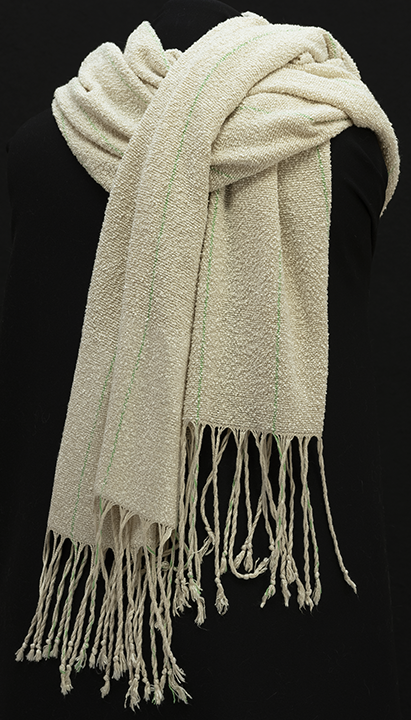
With winter come the holidays and with the holidays come parties, travel and family get together, which led to more Covid-19 cases and more deaths. Unless you stay home and miss it all.
In the middle of this depressing season, came a glimmer of hope: vaccines approved for emergency use, which basically means that they are effective, but there is a lot we don’t know about them, they are mRNA vaccines, they work differently than the usual flu vaccines. mRNA vaccines have been in the making for a long time, notably for the SARS-I, but when that epidemic was averted, funding for the vaccine type decreased and thus it took longer for the SARS-II, aka Covid-19 vaccine to come into being.
Colleagues in the health care field were getting vaccinated; they talked about the few side effects, and the relief that they felt having some protection. Just a few months and we, too, could be vaccinated.
That glimmer of hope translated to green threads to me. Green seems to be a common color for hope. I used 2 threads of 10/2 green silk from RedFish Dyepworks. The fabric is plain weave, so in order to have a solid line of green, I needed two threads. Here is a close-up of the fabric:

And white is associated with winter, I guess because of the snow. Even I think of white for winter, although I didn’t see snow until I was 13 and then it was not love at first sight – my first step into the white stuff resulted in my sliding into the snow with a sore bottom. And I have lived in the South for over 40 years where I can count on my one hand, the number of snow storms we have had, most of which were gone overnight. Ironically, while I was weaving this piece, Mississippi had the worst snow storm that I can remember. The city shot down for a week.
The white warp was easy enough; I have a silk from my stash, close to 20/2. The weft I had to think about. I wanted texture, but not hair yarn, for example. I thought of textured handspun, but I only have a couple of bobbins in reds; I would have to spin some, not a good option. I looked through my shelf that holds black and white yarns and there was my answer: white silk bouclé.
I had bought several skeins of silk bouclé dyed for the colors of the Convergence® in Long Beach, CA by RedFish Dyeworks. I loved the yarn feel and look; I wove this shawl with it:
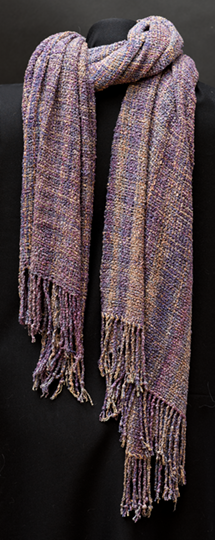
And here is a close-up:
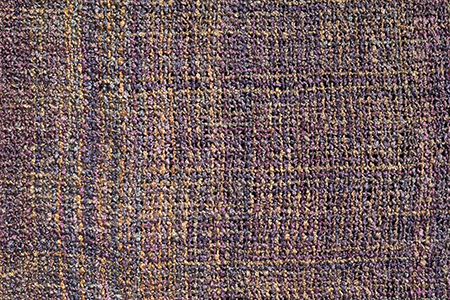
At the Convergence® Marketplace, I wanted to buy more silk bouclé from RedFish in different colors, but they only had 5 skeins of white. I bought those, thinking that I would dye them.
The dyeing never occurred, but the white yarn was perfect for this project. I thought of using it for warp and weft as I had done for the colorful shawl above, but 5 skeins wasn’t enough: each has 150 yards for 100 grams. I used nearly 4 for the weft alone.
I opened up the sett for the 10/2 silk warp to 18 epi to accommodate the larger weft. There are 5 two-threads green silk threads dispersed over the width of the shawl, 22” on the loom; that translates to the green every 4th inch, except at the edge which ends with 3” of white.
The final shawl is 19” by 95”. This is one piece out of the Covid-19 series that I will wear, maybe to concerts for the 2021-22 season.
Stay safe and happy weaving!
Marcy
Fall 2020: Fire and Ashes, Water and Mud – Amidst Covid.
Marcy Petrini
January, 2021
Here is the scarf by that name:

As summer gently slipped into fall, we continued our daily and weekly routines to keep body and souls together.
The inside world was good enough, but the outside a disaster. By Labor Day this country had 22% of the world’s deaths, even though our population is only 4%: 183,000, the numbers are both staggering and numbing. And unemployment, failed businesses… and then racist violence.
Just as we thought we couldn’t handle anymore, Mother Nature lashed her anger. Fires out west, tornadoes on the Gulf Coast – heart-wrenching devastation.
I turned to my weaving.
The colors from the reports were vivid. The colors would tell the story.
I found some 5/2 silk that would be appropriate for the rigid heddle, with a sett of 12. Starting with the red fires turning to black ashes on one side, and starting with aqua, turning multi-colors of brown, greenish, blackish, as the water retreated and left mud. The ashes and mud met in the middle. The red seemed to have given away to grey in the virus, but there is red for blood from the violence, too.
I envisioned a slightly warp dominant plain weave, to focus on the colors. So, for weft I thought I had just the perfect yarn: a multicolored black to white silk, with lots of greys. When I found the yarn on my shelf, although I still love it and I have used it in a couple of projects, it was bigger than I had remembered. It was worth the try, anyway.
I made the hem with some of the 5/2 black, thinking that it would work better than the multicolored silk, especially if I decided not to use that silk.
After weaving a few inches, the result was a weft-dominant fabric with irregular stripes of black, grey and white. Not the look I was going for. Back to the drawing board for weft.
On the shelf there was a big cone of an identified grey cotton, unmercerized with a nice sheen, which wraps at 30 epi, probably 8/2. I tried it. It worked perfectly. Large enough to make the fabric stable, but small enough to result in a warp dominant scarf, not adding to the weight and keeping a good drape.
So, I wove away and finally got to the end. I hemmed it with the grey cotton. Time to unroll, only to stop dead on my tracks. I had completely forgotten about the hem with the fat 5/2 black silk at the beginning of the scarf. I tried to convince myself that it would be all right, but I wasn’t convinced enough to take the scarf off the loom. I left it overnight to make a decision.
The next morning, in the bright light of my studio, the original hem looked even worse. I decided I would use the grey cotton and hem the beginning of the scarf before I cut off the black silk hem which I could use as a guide. I sewed the hem and took the scarf off the loom.
As I was about to cut off the original black hem before wet finishing, I noticed that the grey hem from the night before was not straight. Sometimes I caught 2 weft threads, sometimes 3. Now determined that it was going to be right, I cut off the new grey hem, placed a white guide thread up to where the hem should catch and hemmed it again. This time it was successful. I was able to pull out the white guide thread and cut off the black silk hem. Finally ready for wet finishing
I am thinking that this scarf took longer to hem than it did to weave! But it’s done. Here is a close up.

Meanwhile, winter started rolling around…..
Stay safe and happy weaving!
Marcy
2020: The Spring That Never Was
and Summer through My Window, no Place to Go
Marcy Petrini
December, 2020
Here is the scarf:
2020: The Spring That Never Was
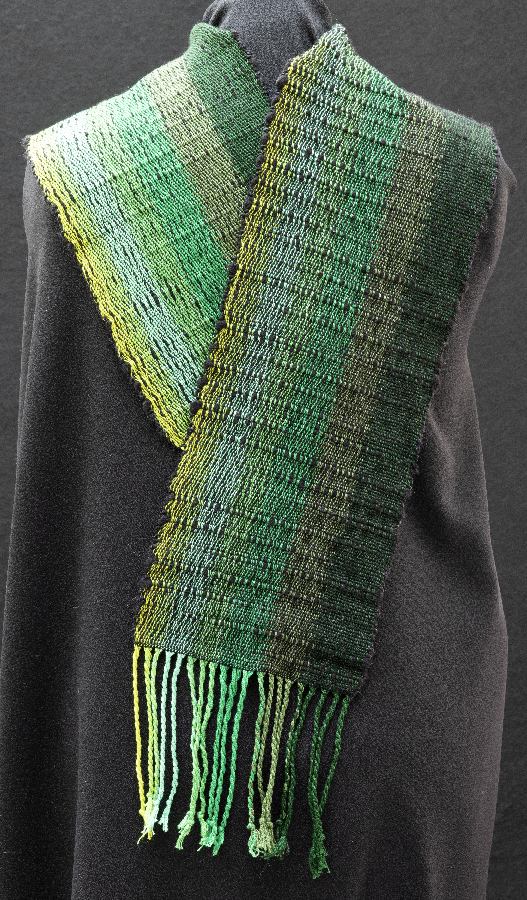
No, it’s not very “pretty”, but neither are the deaths of nearly 120,000 Americans for whom spring never was.
Spring comes early to Mississippi. The yellow-green pine pollens blanket the neighborhood: the ground, cars, roofs. The first spring rain washes out the pollens and gives way to more greens, bright at first, then turning darker. But in my mind that green became darker and darker as spring progressed. Dark army green. After all, this is a war we are fighting against this virus.
Yes, there are the dumb deaths: “It’s just a little cold”, which it is, until it isn’t.
Or the foolish deaths: “Let’s have a covid party, that way we can get infected and then go on with the rest of our lives.” Except the virus decides whether there is a “rest of your life.”
But I am saddened by the death of those who caught the virus early on, before we knew how infectious it can be before symptoms, or even without; before we knew that masks and social distancing can help.
And my heart does to the elderly and the disabled who lived in facilities where the caring and respite turned into death row. Or the grandma whose grandson thought “it is just a little cold.”
But most of all my heart is broken by the deaths of the health care givers and first responders who died helping others, sometimes with little protection, knowing the danger but choosing to do what was right for their patients. And made the ultimate sacrifice.
So I turned to my weaving. I envisioned a green scarf with progressively darker greens. Not much blending, deaths marches on in a linear way.
I wanted the fabric to be two sided, but not overwhelming so. I thought a 2/1 twill would provide it. The 10/2 cottons from Lunatic Fringe offer a variety of greens; I used 7 in the warp, sett at 30 epi, and planned on 10/2 black for weft. The drawdown is below (with a reduced number of greens).
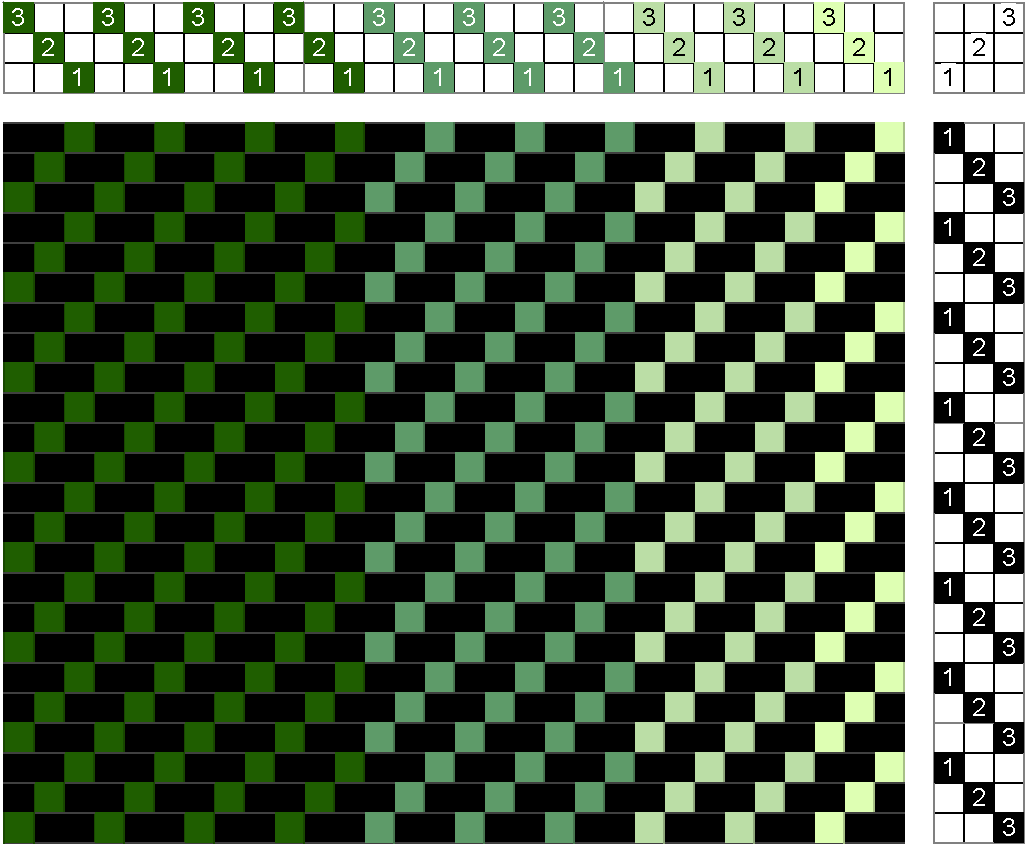
I hadn’t woven a 2/1 twill in a long time; more recently I wove a 3/1 twill, but it was a while back, too. My recollection, however, was that the edges of such an unbalanced fabric can curl up. I thought I could prevent it by threading a selvage, using the 4th shaft that was not part of the twill; I could thread a pseudo basket weave, which would still need floating selvages, but provide some stability and prevent the curling. The drawdown is shown below.

I began to weave, but the 10/2 black just didn’t match the idea I had in mind. I decided there wasn’t enough texture. I tried a couple different wefts, and finally I found on my shelf the Universal Yarn “Bamboo Bloom Lights out”, black, thick & thin, 48% bamboo, 44% wool, 8% acrylic. The thick and thin provided the texture.
I also didn’t like the pseudo basket weave at the edge, probably because the sett of 30 epi was too close, but also the intersections didn’t look right with the bamboo blend. So, I took the 6 threads on each side and rethreaded and re-sleyed them for the twill. I was finally ready to go.
It’s not unusual for me, if I am weaving with something specific in mind, to rework the project as I go. I change wefts often, I re-sley if need be. Sometimes changing the weft results in needing a different sett. I have also re-threaded if I haven’t liked the pattern after all. I think of my warp as a canvas, it does not need to be static.
The scarf is a bit heavy but it has some drape, certainly less than my usual scarves. But that’s ok, this is one scarf I don’t plan on wearing.
Here are the close ups of the fabric:
 |
 |
On the left is the top as I was weaving; because the floats are only over 2 threads, and the sett is rather dense, what we may expect as the weft-dominant side is not. On the right is the bottom as I was weaving, warp dominant, with the weft poking through in the thick parts.
At the end of a project, I always ask myself: if I were to do this again, what would I do differently. In this case, I think the 3/1 twill would have made the weft-dominant and warp dominant more obvious. And the thick and thin yarn would probably have prevented the curling anyway. Each project offers some learning.
As macabre as it may sound, while I was weaving, I thought of all the dead underneath the earth, looking up to our green spring. They are gone. We could have prevented a lot of those deaths. We didn’t.
Here is the scarf:
2020: Summer Through My Window, No Place to Go
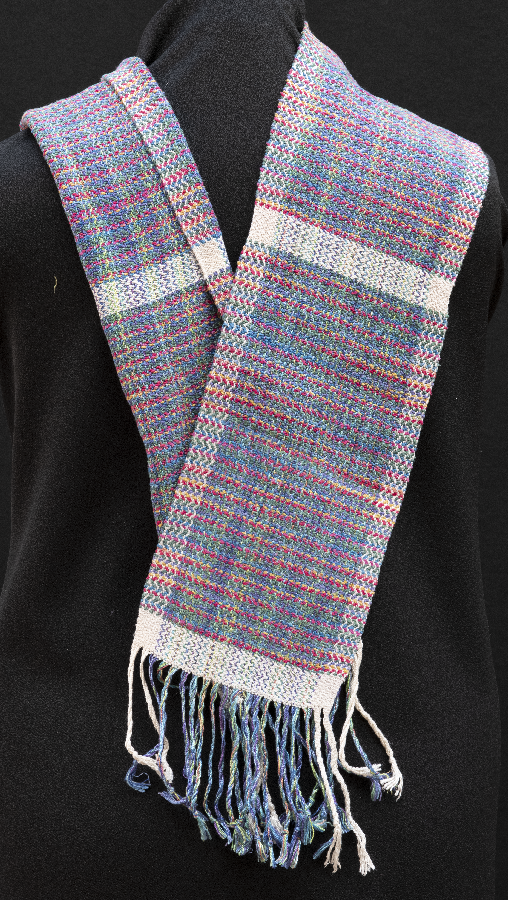
Memorial Day weekend is the unofficial beginning of summer and what a better way to start than a Mississippi Symphony Orchestra concert on the grounds in front of the Vicksburg Military Park. But in 2020, cancelled.
There is no more relaxing way to spend summer evenings than at the ballpark, cheering our local team, the Mississippi Braves. But in 2020, no minor league baseball.
Wherever I go, my travel journal goes with me. This year it stayed in the drawer. No Convergence®, no travel, not even a little excursion.
But I have my window, a great view of the backyard from my studio.
Really, I can’t complain. I have my health, good food, shelter, work that keeps me busy and happy, and the good companionship of my husband. I have so much while others have nothing.
In the evenings we sit in the patio right outside the studio window, but during the day, I watch from inside. It’s hot and humid outside, so Mother Nature’s colors are muted: the golden sun filtering through the greens of the trees and plants; the blue of the jays as they fly around looking for their favorite seed, the blackbirds’ feathers so shiny that they looks purple.
And the reds: the red of the hummingbirds as they flutter by the feeder, the crimson of the male cardinals looking for a mate; the showy reddish pink of the throats of the lizards as they scurry along the small wall in front of the studio, the bright red of the woodpecker on the tree across the yard, and the burgundy of the fruits of the two cacti that Terry rescued when the local Mexican restaurant closed.
I love those reds.
But then I think of covid red.
How did covid become red? The now familiar picture of the round virus with spikes comes from electron micrographs, which are in black and white, not red.
Did an artist render it red early on to alert of danger?
Did a pulmonologist describe the red inflammation caused by the virus in the damaged lungs of his patient?
Did the cardiologist fear the red clots that could kill her patients just as they seemed to turn the corner?
I don’t know, but red it is.
I try to look at the beauty and not think of that red.
So, I decided to weave it.
I chose some 10/2 Tencel left over from past Convergences®, by Just Our Yarn, Water and Fire, alternating with Wood Violet in the warp, sett at 24 epi.
For the structure, I wanted a twill, but I wanted the floats to be of different lengths and not in the same direction, so I used an undulating twill threading with a pointed twill treadling. At that close scale, I knew the twill would not show, but my plan was for the twill floats and their directions, not the actual pattern.
That’s for the view. My window frames are painted off white, so I needed an off white border. I found some shiny silk in my stash, which I set at 16 epi, 1” on each side, threaded as a straight draw. Below is the drawdown of one repeat of the twill with the two edges. I used floating selvages since a pointed twill treadling doesn’t catch every warp thread.

The plan was to weave 1” with the off-white silk, 12” with a weft yet-to-be-determined, and another 1” of off-white silk to make the “windows.”
Where the off-white silk weft crossed the warp in the middle, the colors of the warp show up, but that is ok, my window frames are shiny, and they reflect the outside colors.
After the 1” of off-white silk, I started trying various colors of 10/2 Tencel and 20/2 silk, which are close enough in size to work well with the 10/2 Tencel warp.
Nothing worked. The colors blended too much.
I should have thought that there would be optical blending, with so many colors and relatively small threads, especially from a bit of a distance, as we would be looking at a scarf being worn. Normally our brains first detect the edge of a shape, then the color is filled in; this is called the edge effect. But if we have poor resolution of the shapes, as with small threads, the brain cannot distinguish the shapes and it blends the colors. This is a useful technique when we want to work it that way – we can put red and blue together and the piece will look purple from the optical blending. But I wanted individual colors to appear and not blend, so using the same size weft on a multicolor warp did not work well. Back to the yarn shelf.
I found a matt 100% silk hand-dyed by Margaret Pittman of Heritage Yarns who has sadly now retired. Her colors have always been wonderful. The yarn has reds, greens, blue, purples, and gold, variegated, which Margaret called Spring at Rocky Springs (a real place in Mississippi), but those are the colors in my yard. There were 16 picks per inch once I started weaving, which made the scarf more weft dominant.
Here is a close up of the “window”:

Despite being weft-dominant, the scarf drapes well, silk, even matt provides the drape.
Just as I was getting used to the new – hopefully temporary – normal, autumn rolled around with more destruction. When will this end?
Stay well and safe – and happy weaving!
Please email comments and questions to
